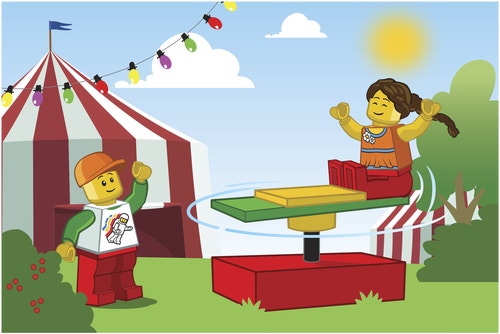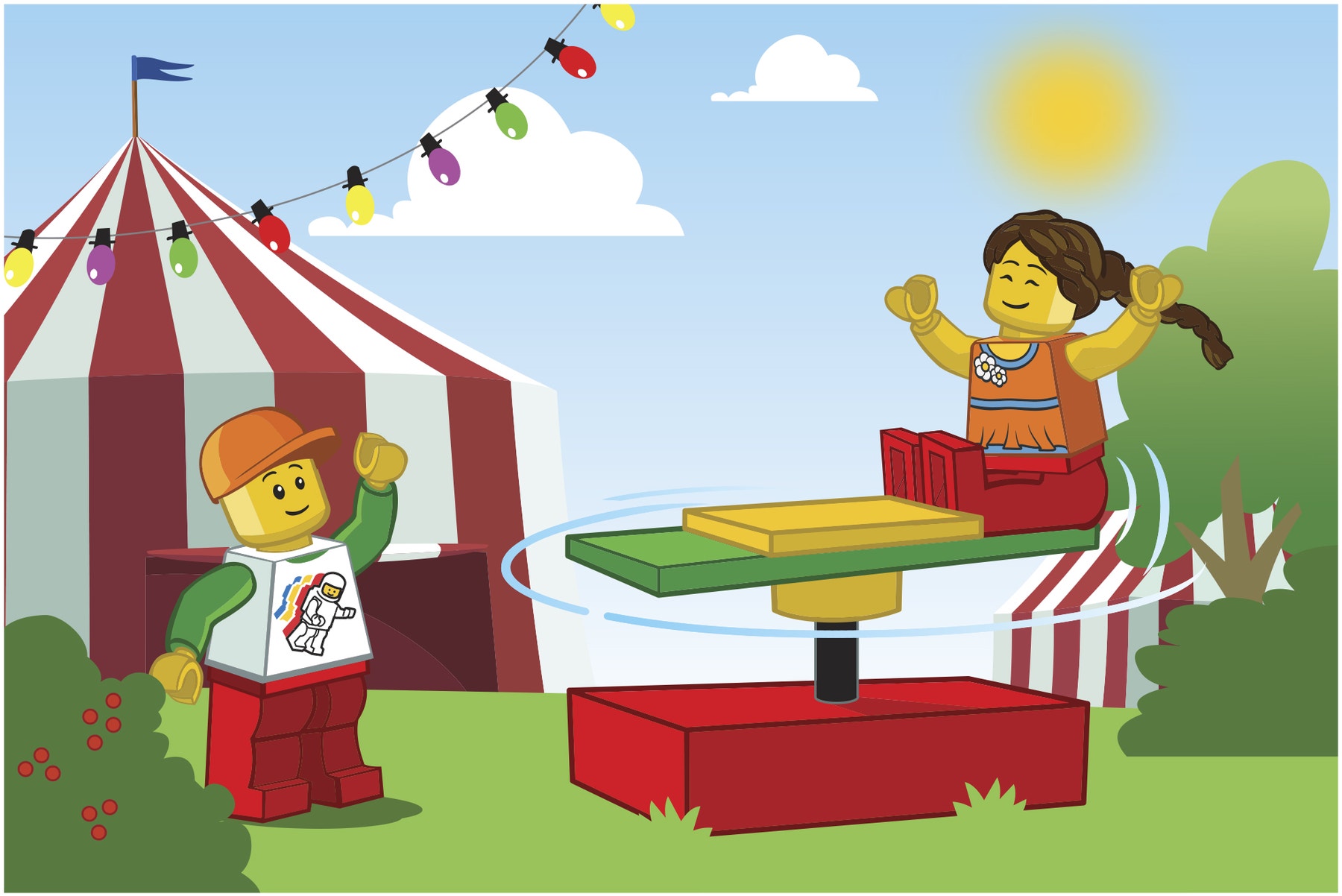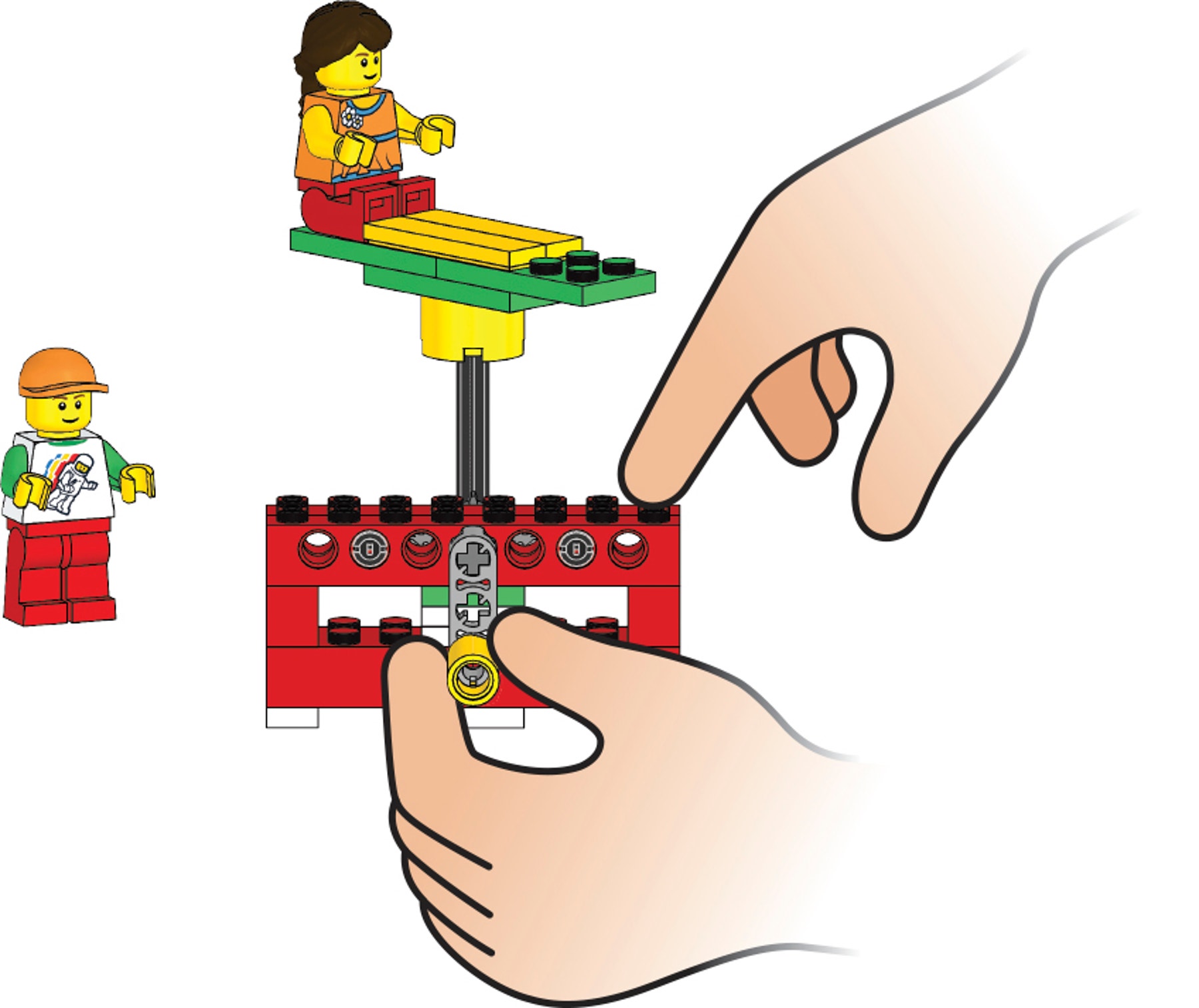Merry-Go-Round
Explore and recognise that how fast or how slowly one gear makes another turn depends on the number of teeth on the gears and their position.

Connect
(5-10 Minutes)
Sam and Sally love going to the fair. The ride they enjoy most is the merry-go-round. It’s such fun to spin around and around, waving to their friends and families!
Do you like merry-go-rounds?
What do you enjoy most about them?
Which simple machine might be needed for a merry-go-round to turn?
Let’s build a merry-go-round!

Construct
(10-15 Minutes)
1. First, build Merry-Go-Round Model A6 and make it turn.
Follow Building Instructions A, pages 34 to 42, steps 1 to 11.
When Merry-Go-Round Model A6 has been built, check the following:
Crank the yellow handle to make sure the merry-go-round turns.
Make sure the minifigure is attached securely. Students are welcome to use either Sam or Sally, but they should be told that it is easier to count how many times the merry-go-round makes a full turn with only one minifigure on the merry-go-round.

Hint
Students should be reminded that the drive gear is the gear turned by an outside effort, in this case your hand cranking the yellow handle.

Contemplate
(10-15 minutes)
2. Count the teeth on the gears. Start counting from the dot.

There are two gears used in model A6: a spur gear (8 teeth) and a crown gear (24 teeth).
3. Then look carefully at the pictures of the models and compare Merry-Go-Round Model A6 to Merry-Go-Round Model A7.
Circle what is different.
What do you notice? Explain how the models are different.
Learners should notice the difference in both size and number of gears used on model A6 compared to model A7.
4. Next, look carefully at the pictures of the models and make a prediction.
If I compare model A6 to model A7, then I think Merry-Go-Round Model (A6/A7) will turn faster.
*Encourage learners to discuss the effects the different gearing has on the merry-go-rounds in their own words. For the prediction, the correct answer is model A7; however, it does not matter whether learners get the answer right or wrong at this point, only that they should make a prediction that can be checked later.
5. Test Merry-Go-Round Model A6.
If you want Sam or Sally to make a full turn, how many times must you crank the handle?
Have learners observe the starting point of both the handle and the minifigure. Encourage them to try more than once, to ensure that their observations are correct. Learners must write their answer on the Student Worksheet.
The learners will have to crank the handle three times for Merry-Go-Round Model A6 to turn once. The gear ratio is 3:1; this is a gearing down arrangement (because 24/8 = 3/1), and the merry-go-round turns slowly. Learners should be made aware that the angled gearing enables the rotary motion to be transmitted through a 90-degree angle.
Note:
If possible, keep an example of Merry-Go-Round Model A6 for learners to compare with Merry-Go-Round Model A7.
6. Build Merry-Go-Round Model A7 and make it turn.
Follow Building Instructions A, pages 44 to 52, steps 1 to 11.
Encourage learners to identify the gears and count the teeth on the gears. There are four gears used in the model: two small spur gears (8 teeth), a crown gear (24 teeth), and a large spur gear (40 teeth).

7. Test Merry-Go-Round Model A7.
If you crank the handle three times, how many times does Sam or Sally make a full turn?
Have learners pay attention to the starting positions of the handle and the minifigure as described earlier. Encourage them to try more than once, to ensure that their observations are correct.
Three turns of the 40-tooth gear produce five turns of the merry-go-round. The gear ratio is 3:5 (because 24/40 = 3/5) and the merry-go-round turns at a much faster pace.
Hint
It is recommended that learners work in pairs; one learner can observe the minifigure while the other cranks the handle a full turn.
8. Finally, draw a conclusion and check your prediction.
Merry-Go-Round Model A7 turns faster because of the gearing-up arrangement with the 40-tooth drive gear and the 24-tooth driven gear.
Continue
(10-15 Minutes)
Learners are encouraged to explore the gearings illustrated on the Student Worksheet and to record their observations.
Note:
There are no building instructions included to guide learners through the Continue phase, other than the illustrated suggestions on the Student Worksheet.
Encourage your learners to discuss the effects that the gearing in focus will have on the merry-go-round in their own words, prompting them with questions such as:
Describe what happened when you turned the handle.
How many times did you have to turn the handle to make the merry-go-round turn once? Why do you think that was?
Describe how the model works.
What did you do to make sure your observations were correct?
It is suggested that learners should draw a gear train (many gears meshing) or items where they find gears used in everyday machines and mechanisms. For inspiration, read or show the 'Overview: Gears’ section.
Optional
With more advanced learners, you might consider introducing compound gearing or gear ratios. Ask what the gear ratio is, and how much faster or slower than the handle the merry-go-round will turn.
Teacher Support
In this activity learners will build and test models that use the following techniques associated with gears:
• Decreasing speed of rotation
• Increasing speed of rotation
• Gearing at an angle
9689 Simple Machines Set (two students per set recommended)
Science (English National Curriculum)
• Scientific enquiry
• Physical processes
Design & Technology (English National Curriculum)
• Working with tools, equipment, materials and components to make quality products
• Evaluating processes and products
• Knowledge and understanding of materials and components
Mathematics (English National Curriculum)
• Number (fractions, percentages and ratio)
• Shape, space and measures (reasoning)
• Shape, space and measures (understanding properties of shape)
• Shape, space and measures (Understanding properties of position and movement)
• Understanding measures
Pupil Material
Share with:
 Google Classroom
Google Classroom



